
You can get a conversion kit for your 1911 for less money than many new .22 LR pistols cost, giving you a familiar, cheap and invaluable training tool.
Why you should consider a .22 LR conversion kit for your 1911:
- Less expensive than an identical pistol in the caliber.
- Ammunition is more affordable, so you'll shoot more.
- Identical in operation to the larger caliber.
- Lighter recoil allows you to focus on fundamentals.
- On most models, easily switches between calibers.
I’ve been teaching people to shoot since 1980. My first experiences were through our local community college, teaching women to shoot. My students were mostly single women who primarily were interested in personal defense and most had zero shooting experience prior to signing up for the class. I suspect I learned as much in that first series of classes as my students.
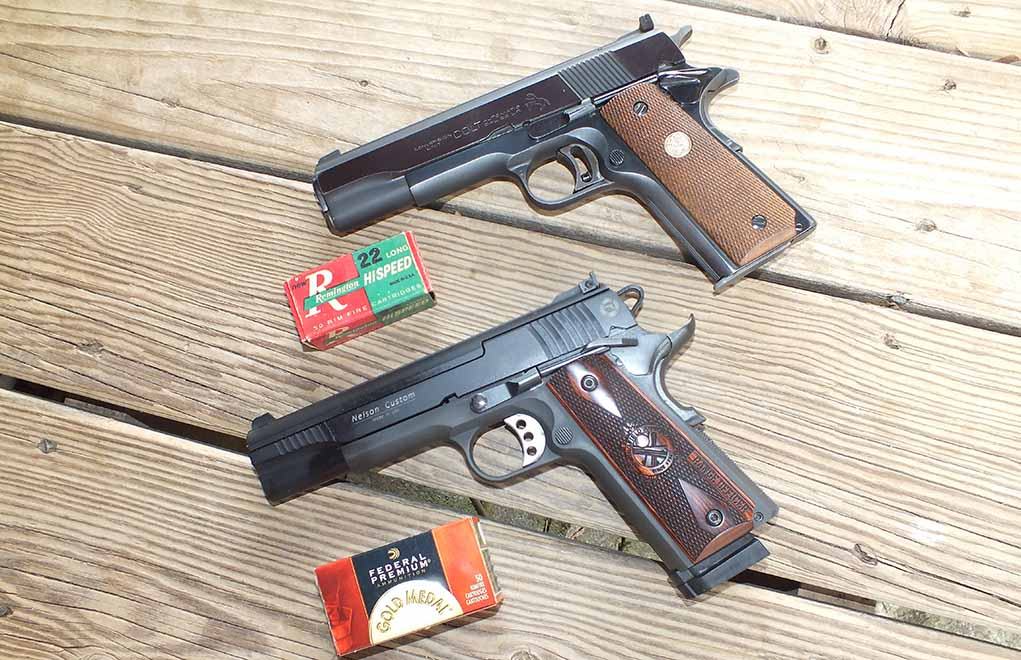
My students brought a varied collection of guns to those original classes, mostly .38 caliber revolvers and full-sized semi-autos. Remember that in those days we didn’t have the excellent choices we have today, and gun size was less important because North Carolina didn’t have a concealed carry permit system.
I quickly found that most of my new shooters experienced difficulties learning to shoot with a full-power handgun because of recoil and noise generated. I began bringing .22 LRs to the class and was immediately impressed by how much quicker they learned.
The Teaching Power Of A .22 LR
In retrospect, I should’ve realized the benefits of learning with a .22 since that’s exactly how I learned to shoot because, as a young man, I simply couldn’t afford to shoot the number of rounds required to truly become proficient. Now I know some of the best shooters in the world on a first-name basis, and all of them use .22s for training — both for the people they train and for themselves.

When I began shooting in the late 1960s, there were few choices of suitable rimfire trainers for semi-autos. If you were a revolver shooter and wanted to do some rimfire training, there were a lot of options. Smith & Wesson had rimfire versions of their excellent Combat Masterpiece in Models 17 and 18 — and even a 2-inch J-Frame in the Model 34. Colt offered their Diamondback in .22 Long Rifle and the Frontier Scout operated exactly like the full-sized six shooters, but was a bit scaled down.
Check out these other great articles on:
- Perfecting A Colt 1911 With Holster, Sight And Grip Upgrades
- Colt 1911 .45 and other chamberings
- Colt 1911 competition pistols
- Colt 1911 grips, holster, sights and other accessories and upgrades.
Semi-auto shooters had zero choices in guns identical in operation to their full-sized counterparts. Though there were Colt, High Standard, Ruger and Smith & Wesson semi-autos that were excellent pistols, they bore little resemblance or operational characteristics to the big guns.
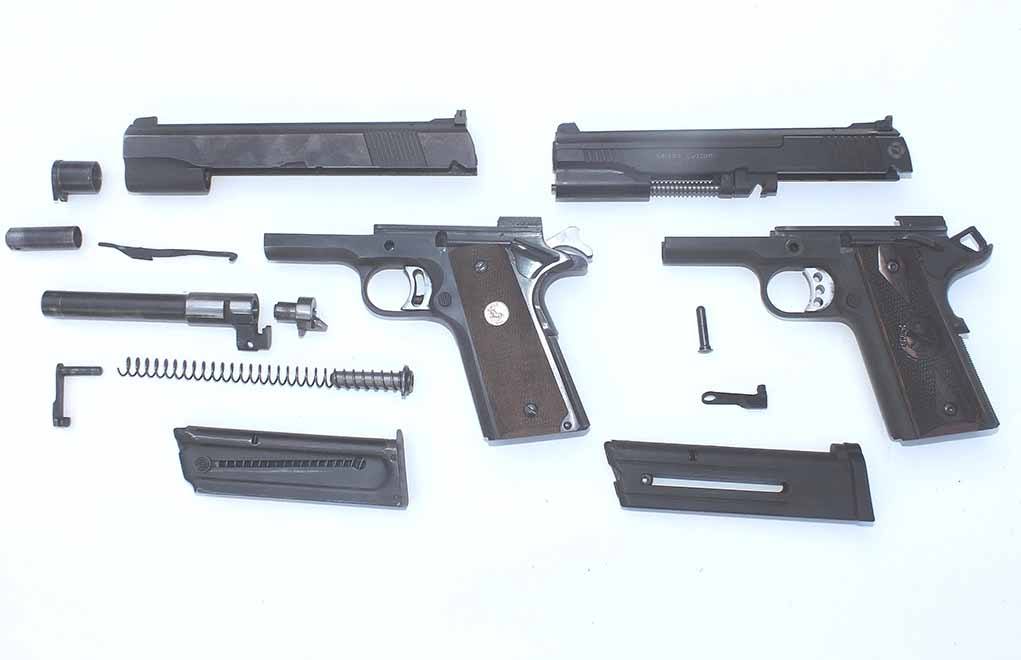
Colt did offer a .22 rimfire conversion unit for their 1911s, but we’ll discuss this a bit later. Today, we have a lot of replica trainers in .22, and many are operationally identical to the real thing. GSG, Walther and others offer rimfire pistols that are dimensionally and operationally identical to the 1911, but while the look and feel is like the real thing, accuracy is only suitable for close range training and plinking.
The problem was physics. The .22 Long Rifle round doesn’t generate enough energy to carry the slide of a 1911 to the rear to eject a spent case while compressing a spring capable of stripping a round out of the magazine and carrying the slide forward into battery. Colt solved the problem by designing a floating chamber that allowed the chamber to gain enough momentum to cycle the slide.
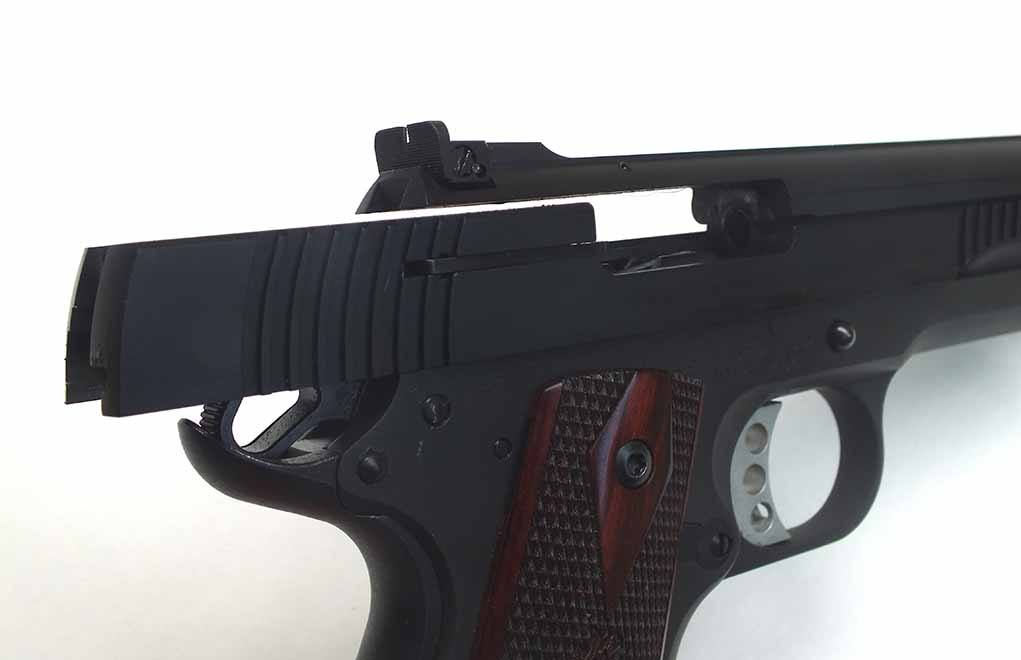
Like so many solutions in life, the solution to one problem created another. With the floating chamber, accuracy suffered and the additional surfaces required by having a chamber floating in a barrel required lots of maintenance because of fouling. It worked, but not really well. Accuracy suffered further because the barrel rattled around in the slide loosely secured only by the slide release pin.
Converting For Training And Fun
There’s an option that’s quietly winning the favor of more and more of the best shooters who wish to train with a rimfire, and it’s not only been around a long time — it’s also accurate enough to win matches at a national level. The Nelson Custom Guns 1911 conversion has a long history with competitive shooters. Bob Marvel was well-known for building competition 1911s for both the .45 and centerfire stages of conventional pistol competition. He decided it made sense to use the same identical grip frame for the .22 rimfire stage of a 2700 pistol match and designed his .22 rimfire conversion for the 1911.
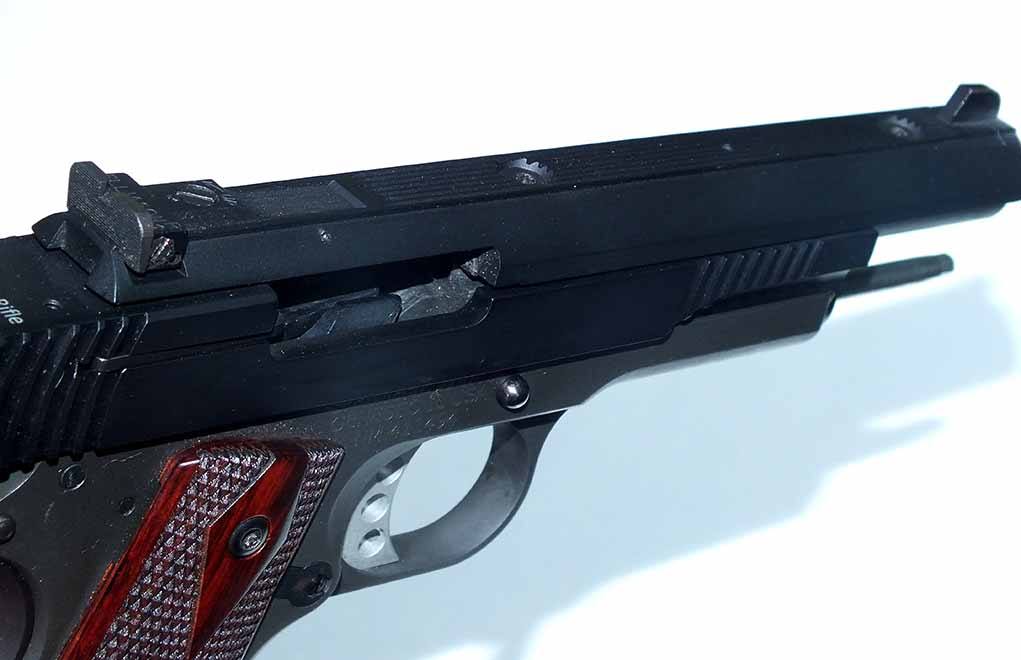
In order to get the level of accuracy required, it only made sense to use a fixed barrel, so the Nelson conversion fixes the barrel to the frame via a recoil spring guide rod that tightens the barrel into the frame on the modified slide-lock pin. The slide lock furnished is in two parts to allow the slide lock to function normally, even though the pin portion of the slide lock is used to fix the barrel in place. The aluminum slide has a steel insert that serves as the breech face.
The top of the barrel is milled to accept a recessed rib that is removed with two screws. The ribs are interchangeable so the user can have a rib with the excellent front post and Elliason rear sights, and switch out iron sights for a scope mount. Currently, Nelson is working on a top rib that incorporates both iron sights and a scope mount to allow shooters to use the scope in open classes and remove it for limited class events or practice.
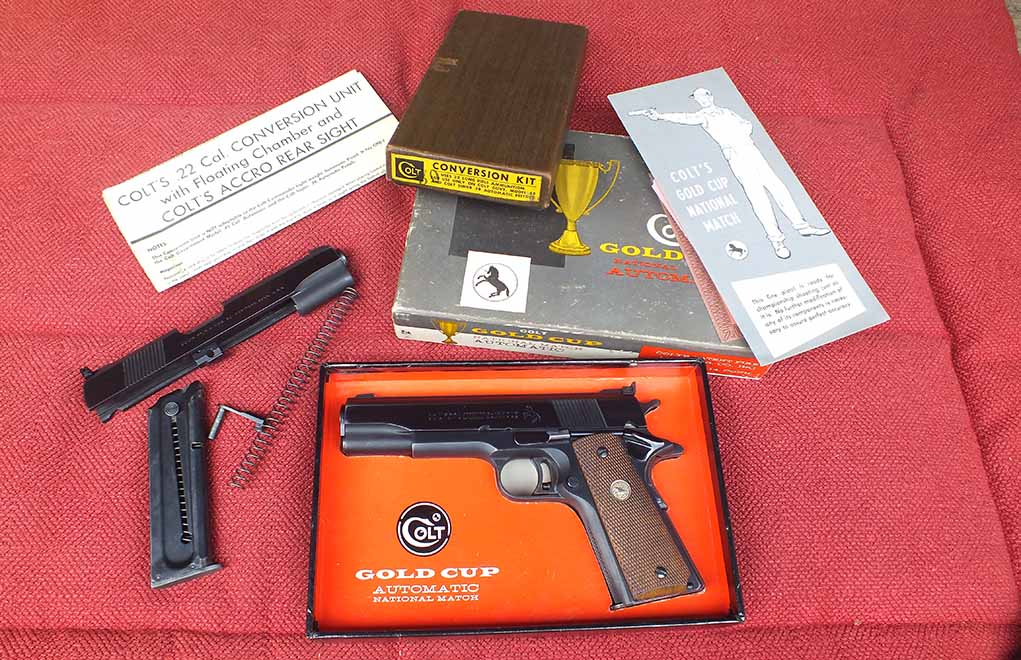
I installed the Nelson conversion on a Springfield Armory Range Officer in .45 ACP, but the system will work on any 1911 in .45, and with a minor fix, a 9mm or .38 Super. The conversion takes about a minute and will work on both single-stack and double-stack 1911s by using different magazines. Since I’ve had the unit, I’ve run more than a thousand rounds of different brands through it with zero malfunctions. Accuracy is on par with the very best semi-auto rimfires on the market, and I’m not talking about standard across-the-counter pistols — I’m talking about the best guns made by Hammeril and Pardini.
Shooting the Nelson Conversion is like shooting your favorite 1911, except for the low cost and minimal recoil. Unless you have a full race pistol and the very best ammunition, it’s more accurate. The iron sights on my unit are identical to the sights on my 1968 Colt Gold Cup National Match. The magazines are easy to load whether you use the supplied magazine spring compressor or not. Magazines are polymer and drop freely when the release is pressed. Sight adjustments are easy and precise.
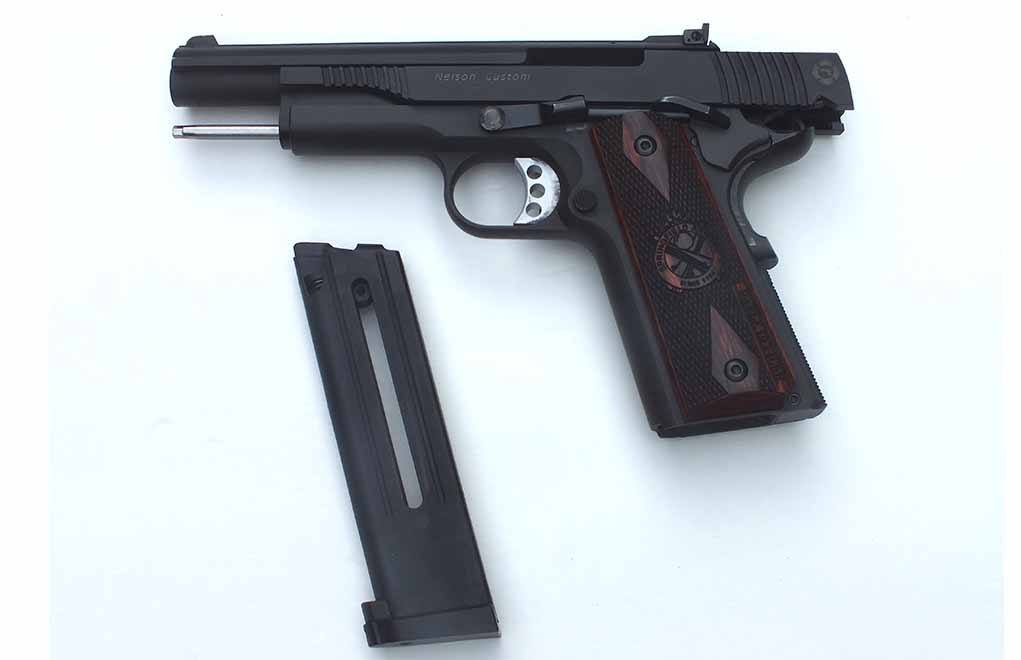
The upshot of all this is the ability of a competitor to shoot the exact trigger and operational system as their centerfire competition pistol. In fact, that shooter is using his competition pistol, just converted over to shoot ammunition at a fraction of the cost, and this benefit comes with accuracy that’s likely to exceed the level of accuracy of the shooter’s competition gun.
While the original Colt conversion was a wonderful tool, it left a lot to be desired in accuracy and reliability. For a design from 1937, it was a remarkable tool for training, but today we have a much better option.
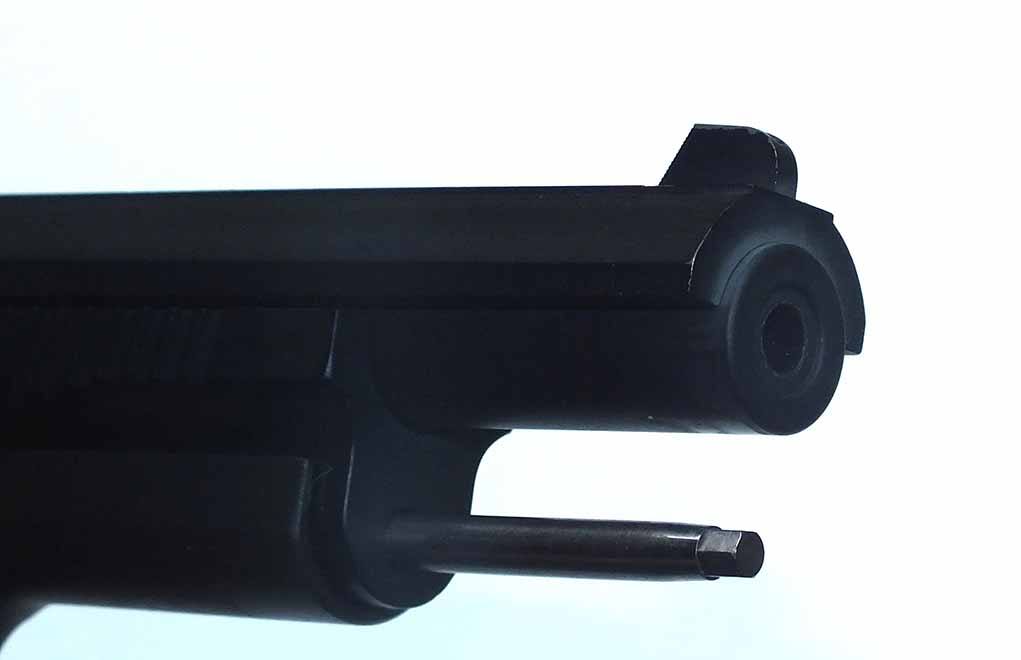
Providing match-pistol accuracy, adaptability to both single- and double-stack pistols and at a price of $480 (which is below that of the average recreational level .22 pistol), Nelson’s .22 conversion satisfies the need of any shooter wishing to utilize the most enduring pistol design in history as a low-cost trainer.

Next Step: Get your FREE Printable Target Pack
Enhance your shooting precision with our 62 MOA Targets, perfect for rifles and handguns. Crafted in collaboration with Storm Tactical for accuracy and versatility.
Subscribe to the Gun Digest email newsletter and get your downloadable target pack sent straight to your inbox. Stay updated with the latest firearms info in the industry.

![Best Concealed Carry Guns In 2025 [Field Tested] Wilson Combat EDC X9S 1](https://gundigest.com/wp-content/uploads/Wilson-Combat-EDC-X9S-1-324x160.jpg)


![Best 9mm Carbine: Affordable PCCs [Tested] Ruger Carbine Shooting](https://gundigest.com/wp-content/uploads/Ruger-Carbine-Shooting-100x70.jpg)
![Best AR-15: Top Options Available Today [Field Tested] Harrington and Richardson PSA XM177E2 feature](https://gundigest.com/wp-content/uploads/Harrington-and-Richardson-PSA-XM177E2-feature-100x70.jpg)
